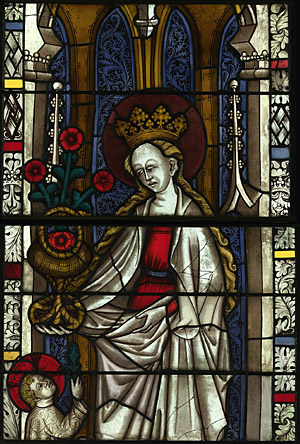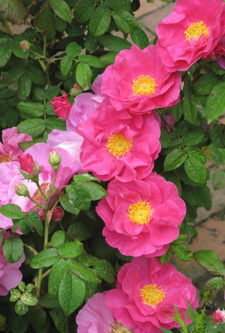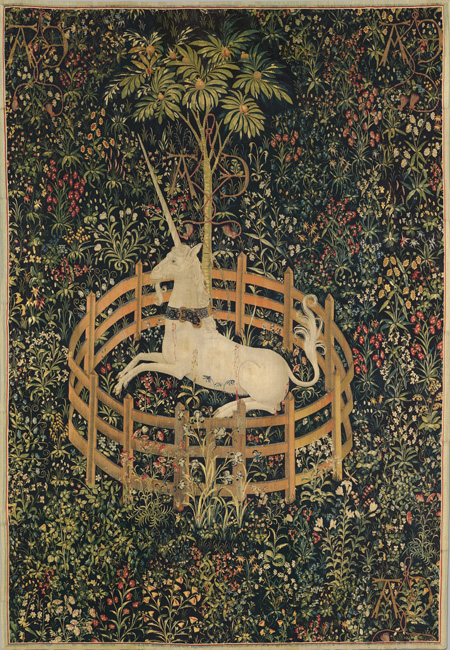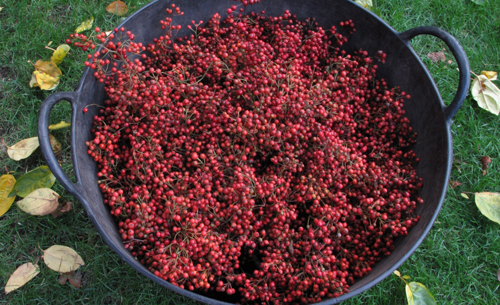Wednesday, August 15, 2012


Left:?? Roses are one of the special attributes of Saint Dorothea, as shown in the detail of this stained-glass panel; Right: Rosa gallica officinalis blooming in Bonnefont garden. Remarkably, the rose has retained its ancient name in dozens of modern languages.
The rose has been known by the same name throughout Europe since antiquity. It began as vrda in ancient Persia (related to the modern Arabic warda) and became known as rhodon to the nearby ancient Greeks. (Oddly, the modern Greek for rose is triantafillo, meaning “thirty leaves,” while rhodon remains in our “rhododendron,” meaning “rose tree”). By the time of the Roman Empire the name had become rosa, immediately recognizable in most modern European languages???rosa (Italian and Spanish), roos (Dutch), ros (Swedish), rosier (French)???and many others, including the Japanese rozu.
Read more »
Tags: carline thistle, Dioscorides, etymology, herb robert, Hildegard of Bingen, Linnaeus, Physica, rose, Theophrastus
Posted in Botany for Gardeners | Comments (2)
Friday, May 25, 2012

The Unicorn in Captivity, 1495???1505. The Metropolitan Museum of Art, New York, Gift of John D. Rockefeller Jr., 1937 (37.80.6). The profusion of flowering plants that springs from the millefleurs meadow on which the unicorn rests includes both garden plants and wildflowers. An iris and a clove pink are prominently placed outside the unicorn’s enclosure; both were intensively cultivated in the Middle Ages, but the purple orchis silhouetted against the unicorn’s body depends on a special relationship with microorganisms in its native soil and would not have grown in gardens.
Roses, lilies, iris, violet, fennel, sage, rosemary, and many other aromatic herbs and flowers were prized for their beauty and fragrance, as well as their culinary and medicinal value, and were as much at home in the medieval pleasure garden as in the kitchen or physic garden. These plants were carefully cultivated, but many useful plants of the Middle Ages were found outside the garden walls, or admitted on sufferance.
Read more »
Tags: colewort, Fennel, gourd, herb, Hortulus, iris, kale, lamb's quarters, lettuce, lily, melon, nettle, poppy, pulse, purslane, rose, rosemary, sage, violet, Walahfrid Strabo
Posted in Food and Beverage Plants, Fragrant Plants, Medicinal Plants, Plants in Medieval Art, Useful Plants | Comments (1)
Friday, October 21, 2011

A tub of rose hips, gathered from roadsides and abandoned pastures upstate, and stripped of their thorns. The hips will be used to decorate the Museum this winter. Photograph by Carly Still
The rose hips used in the winter holiday decorations at The Cloisters allude to the rose symbolism prevalent in medieval Christmas carols. Although we grow medieval rose species in the gardens and on the grounds, their hips are too fleshy for our purposes, and don’t keep well.?? We gather stems of Rosa multiflora, which bear many small, hard, hips, in October, and strip them??of their thorns. They are stored in a cool, dry place until December, when the Museum is decked for the season.
Read more »
Tags: cattle, erosion, hips, Japanese rose, Rosa multiflora, rose, rose hip, weed
Posted in Food and Beverage Plants, Gardening at The Cloisters, Medicinal Plants, Useful Plants | Comments (1)




